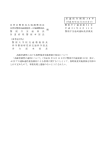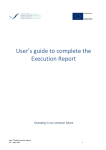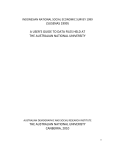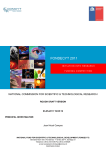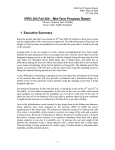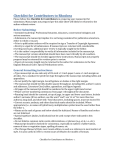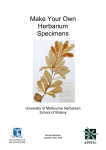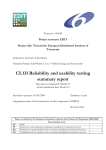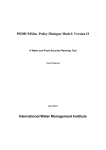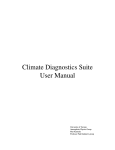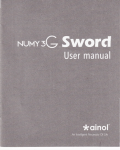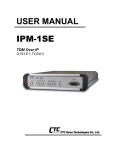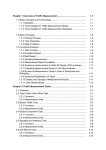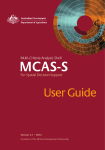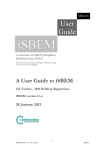Download Nutrient Expert for Maize Manual 02Mar10 - IPNI
Transcript
Nutrient Expert for Hybrid Maize User Manual Version 1.0 Mirasol Pampolino1 Christian Witt1 Julie Mae Pasuquin1 Philip Joshua Sinohin2 International Plant Nutrition Institute Southeast Asia Program Penang, Malaysia December 2009 1 2 International Plant Nutrition Institute (IPNI) International Rice Research Institute (IRRI) Nutrient Expert for Hybrid Maize v1.0 User Manual 02Mar2010 Nutrient Expert for Hybrid Maize Suggested citation: Pampolino M, Witt C, Pasuquin JM, Sinohin PJ. 2009. Nutrient Expert for Hybrid Maize (version 1.0). A software for formulating fertilizer guidelines for tropical hybrid maize. International Plant Nutrition Institute, Penang, Malaysia. © 2009. International Plant Nutrition Institute Disclaimer The International Plant Nutrition Institute (IPNI) and the software do not endorse or promote specific fertilizers and do not guarantee the accuracy of an analysis labeled on commercial fertilizers. The software assumes that the N, P2O5, and K2O analysis labeled on a bag of organic or inorganic fertilizer accurately reflects the content of plant nutrients in the fertilizer. In addition to nutrients, many factors (e.g. climate, crop care, water management) affect maize yield. IPNI and the software do not guarantee a targeted maize yield will be attained with the provided nutrient management guidelines. Limits of liability Under no circumstances and under no legal theory, whether tort, contract, or otherwise, shall IPNI or any of its affiliates, officers, employees, or other representatives be liable to you or any other person for any direct, indirect, special, incidental, or consequential damages of any character including, without limitation, damages or loss of goodwill, work stoppage, computer failure or malfunction, or any and all other commercial damages or losses, specifically including damages to crops and soil resulting from the application of the software, or for any damages even if IPNI shall have been informed of the possibility of such damages, or for any claim by any other party. This limitation of liability shall not apply to liability for death or personal injury to the extent applicable law prohibits such limitation. 2 Nutrient Expert for Hybrid Maize v1.0 User Manual 02Mar2010 System requirements Nutrient Expert for Hybrid Maize requires about 17 MB of disk space and the following: Windows XP or higher MS Office 2003 or higher MS Access 2003 or higher. In the absence of MS Access application, download the MS Access Runtime from the Microsoft website (http://www.microsoft.com/downloads/details.aspx?familyid=d9ae78d9-9dc6-4b38-9fa62c745a175aed&displaylang=en). Acrobat reader 6 or higher (for reading saved outputs as PDF) Installation 1. Extract contents of the Nutrient Expert for Hybrid Maize zip file into a desired destination in your computer. 2. Open the folder on your computer and double click on NE maize.mde to start the software. Software updates Nutrient Expert for Hybrid Maize provides automatic reminder to check for the latest version of the software. By default, users will be reminded monthly to check for updates. However, the user can opt to change the frequency of the reminder (i.e. bimonthly or quarterly) through the Settings page. 3 Nutrient Expert for Hybrid Maize v1.0 User Manual 02Mar2010 The most recent version of the software can be downloaded at the IPNI Southeast Asia Program website >http://seap.ipni.net<. ACKNOWLEDGEMENTS The development team of the Nutrient Expert for Hybrid Maize would like to acknowledge: The following individuals, for their contribution to the development of the principles of Site-Specific Nutrient Management (SSNM) for maize through the collaborative research (2004-2009) between IPNI and their organizations: - Indonesia: Mrs. Sari S. Girsang (AIAT North Sumatera), Mr. Andarias M. Murni (AIAT Lampung), Mr. Samijan Hadisiswoyo (AIAT Central Java), Mr. Suwono (AIAT East Java), Mr. P. Tandisau (AIAT South Sulawesi), Dr. S. Saenong (ICRI), Dr. Sri Rochayati, Dr. D. Setyorini and Dr. F. Agus (ISRI), and Dr. S. Kartaatmadja (IPNI) - Philippines: Dr. Romeo Labios (UPLB), Dr. Apolonio Ocampo (IPB), Mrs. Jocelyn Labios (UPLB), Dr. Cynthia Medina (UPLB), Mr. Hermenegildo Gines (PhilRice), Mr. Carmelito Lapoot (NOMIARC); Mr. Severino Tumamang (CVIARC) - Vietnam: Dr. Pham Sy Tan (CLRRI), Dr. Tran Thuc Son (SFRI), Dr. Do Trung Binh (IAS), Dr. Nguyen My Hoa and Dr. Ngo Ngoc Hung (Cantho University); Dr. Ton Nu Tuan Nam (WASI) The following institutions for their support and partnership with IPNI in conducting the collaborative research on maize (2004-2009): - Indonesia: Indonesian Agency for Agricultural Research & Development (IAARD), Directorate General for Food Crops (DGFC), Indonesian Center for Food Crops Research & Development (ICFORD), Indonesian Cereals Research Institute (ICRI), Indonesian Center for Agricultural Land Resources Research & Development (ICALRD), Indonesian Agroclimate & Hydrology Research Institute (IAHRI), Indonesian Center for Rice Research (ICRR), Indonesian Center for Assessment & Development of Agricultural Technology (ICATAD), and Assessment Institute for Agricultural Technology (AIAT) in the provinces of North Sumatera, Lampung, Central Java, East Java, and South Sulawesi. - Philippines: University of the Philippines Los Baños (UPLB), Philippine Rice Research Institute (PhilRice), Corn RDE Network, GMA Corn, Bureau of Agricultural Research (BAR), Bureau of Soils and Water Management (BSWM), DA-BAR Regional Field Units (RFUs), AFC Fertilizer and Chemicals, Inc. - Vietnam: Ministry of Agriculture & Rural Development (MARD), Soils and Fertilizers Research Institute (SFRI), Western Highlands Agro-Forestry Scientific & Technical Institute (WASI), Institute of Agricultural Science of South Vietnam (IAS), Cantho University, Cuu Long Rice Research Institute (CLRRI) Dr. Achim Dobermann, Dr. Tri Setiyono, and the Nebraska group for sharing maize data in high-yielding environments, which together with the data collected from Southeast Asia formed a large dataset on maize representing a wide range of environments, and used in determining the NPK requirements of maize using the QUEFTS model Dr. Roland Buresh of the International Rice Research Institute (IRRI) for his valuable comments/inputs for the revision of the SSNM strategy for maize The International Potash Institute (IPI) for providing financial support for the development of the Nutrient Expert for Hybrid Maize software The International Plant Nutrition Institute (IPNI), the International Potash Institute (IPI), the International Fertilizer Industry Association (IFA), and Canpotex International Pte. Ltd for funding the project on SSNM for Maize in Southeast Asia. Additional direct and indirect support provided by the collaborating national agricultural research and extension systems is also gratefully acknowledged. 4 Nutrient Expert for Hybrid Maize v1.0 User Manual 02Mar2010 CONTENTS 1. ABOUT NUTRIENT EXPERT FOR HYBRID MAIZE ..................................................................... 7 2. OVERVIEW ....................................................................................................................................... 10 2.1 Assumptions and Conditions ........................................................................................................ 11 2.2 The Five Modules of Nutrient Expert for Hybrid Maize .............................................................. 11 2.3 Steps in Using and Navigating the Software ................................................................................ 13 3. HOME SECTION ............................................................................................................................... 14 3.1 Settings ......................................................................................................................................... 15 3.1.1 Site profile ........................................................................................................................... 16 3.1.2 Inorganic fertilizers ............................................................................................................. 17 3.1.3 Organic fertilizers ................................................................................................................ 18 4. CURRENT NM PRACTICE .............................................................................................................. 19 5. PLANTING DENSITY ...................................................................................................................... 21 5.1 Developing an Improved Planting Density ................................................................................... 22 5.1.1 Row spacing ........................................................................................................................ 22 5.1.2 Plant spacing or within-row spacing ................................................................................... 23 6. SSNM RATES .................................................................................................................................... 25 6.1 Determining Fertilizer N, P, and K Requirements with SSNM .................................................... 26 6.2 Range of Attainable Yield or Yield Goal ..................................................................................... 27 6.3 Look-up Tables for N, P, and K Requirements ............................................................................ 27 6.4 Nutrient Credits from Organic Inputs and Carryover from Previous Crop .................................. 27 6.4.1 N credits .............................................................................................................................. 28 6.4.2 P credits ............................................................................................................................... 28 6.4.3 K credits .............................................................................................................................. 28 7. SOURCES AND SPLITTING............................................................................................................ 30 7.1 Guidelines for Determining the Number of Fertilizer Splits during the Season: .......................... 32 7.1.1 Splitting ratio for N ............................................................................................................. 33 7.1.2 K splitting ............................................................................................................................ 33 7.1.3 Timing and splitting ratio of fertilizer N, P, and K when soil moisture is sufficient (Plan A) ...................................................................................................................................................... 34 5 Nutrient Expert for Hybrid Maize v1.0 User Manual 02Mar2010 7.2 Alternative Plan for ‗Less Favorable Rainfed‘ Environments ...................................................... 34 7.2.1 Guidelines for fertilizer splitting for an alternative plan (Plan B) ....................................... 36 7.3 Use of the Leaf Color Chart .......................................................................................................... 37 8. PROFIT ANALYSIS .......................................................................................................................... 38 9. REFERENCES ................................................................................................................................... 40 APPENDIX ................................................................................................................................................. 41 A. Required Information — questions asked (listed by module) ....................................................... 41 A-1. Current NM Practice ............................................................................................................ 41 A-2. Planting Density ................................................................................................................... 41 A-3. SSNM Rates ......................................................................................................................... 41 A-4. Sources and Splitting ........................................................................................................... 42 A-5. Profit Analysis...................................................................................................................... 42 B. Estimating Attainable Yield ........................................................................................................... 43 B-1. Assumptions ......................................................................................................................... 43 B-2. The upper limit of attainable yield ....................................................................................... 44 B-3. Risk scenarios and estimates of attainable yield .................................................................. 44 C. Estimating Yield Responses from Fertilizer N, P, and K ............................................................... 46 C-1. Guidelines for determining the soil fertility level and N response ....................................... 46 C-2. Guidelines for determining P supply class and P response .................................................. 47 C-3. Guidelines for determining K supply class and K response ................................................. 48 D. Liming ............................................................................................................................................ 49 6 Nutrient Expert for Hybrid Maize v1.0 User Manual 02Mar2010 1. ABOUT NUTRIENT EXPERT FOR HYBRID MAIZE Many countries in Asia have started replacing existing blanket fertilizer recommendations for vast areas with rice, maize, or wheat with more site-specific guidelines adapted to local needs. This process was accompanied with a shift from traditional onstation research to on-farm development and evaluation of novel practices. A key challenge faced by the local extension agencies remains the complex nature of factors influencing nutrient requirements. The software Nutrient Expert for Hybrid Maize was developed to assist local experts in the development of fertilizer guidelines for tropical hybrid maize based on the principles of site-specific nutrient management (SSNM) described by Witt et al (2009). In the following, we present suggestions on how the software could be used in the context of a conceptual framework for the evaluation and dissemination of SSNM for maize in Asia (Figure 1). A framework for the Evaluation and Dissemination of SSNM The step-wise evaluation and dissemination of SSNM is depicted in Figure 1. In brief, the introduction of SSNM in a new region begins with a strategic assessment of needs and opportunities for improvement in crop and nutrient management. Management options are developed and evaluated with participating farmers and key stakeholders in the public and/or private sector extension bodies. Figure 1. Conceptual framework for the evaluation and dissemination of site-specific nutrient management for maize. Once the evaluation is completed, i.e. a new practice has proven to provide sufficient benefits to be of interest to farmers, dissemination begins where guidelines and recommendations are 7 Nutrient Expert for Hybrid Maize v1.0 User Manual 02Mar2010 made available to a larger number of farmers using extension campaigns. An impact assessment provides evidence and feedback for further improvement. It may be necessary to step through this cycle more than once to make necessary corrections in the technology or delivery strategy The conceptual framework is a cyclical process of evaluation and dissemination divided into four key steps: Step 1. Strategic Assessment and Evaluation of Management Options Socio-economic farm surveys are conducted to collect quantitative data on key management practices in major production areas. The information serves as a baseline for future impact assessment and provides guidance in the development of nutrient management options for evaluation. Both the development and evaluation of management options require active participation of a representative group of farmers and partners in delivery. The following tools are used in Step 1: The software Nutrient Expert for Hybrid Maize can be used to develop nutrient and crop management strategies for participatory evaluation. This decision tool will help local experts to formulate fertilizer guidelines tailored to site-specific conditions or agroecological domains. A Manual for Participatory Evaluation describes strategies for the assessment of nutrient management options. Farmers‘ meetings, field trials, and workshops are used to obtain the necessary results and stakeholder feedback for developing a new practice for wider scale delivery. Step 2. Results and Feedback shape the New Practice Results from representative field trials and stakeholder feedback collected during the participatory evaluation are used to develop new management practices for dissemination. Often replacing blanket recommendations at country level, versatile one-page Quick Guides are designed to capture the most important aspects affecting fertilizer recommendations in a region (e.g., soil type, season, residue management, yield target). Using a Quick Guide designed for their region, farmers select the fertilizer recommendation that matches their field-specific conditions. The following tools are used in Step 2: The Nutrient Expert for Hybrid Maize software described in Step 1 is used again in Step 2 to develop a final set of nutrient and crop management strategies for dissemination. A Manual for the Development of Quick Guides is under development. Portraying examples from rice and maize, the manual will help users in designing Quick Guides for their region. Step 3. Extension Campaigns Public or private sector agents may choose to integrate newly developed tools such as Quick Guides in their extension campaigns. When introducing new recommendations to farmers, Quick 8 Nutrient Expert for Hybrid Maize v1.0 User Manual 02Mar2010 Guides are complemented by videos on general crop and nutrient management strategies. A film project on maize is on the way offering a broad dissemination platform for TV broadcasting and distribution on DVD or VCD. Tools used in Step 3 include: Film for introducing principles of crop and nutrient management to larger (TV broadcasting) or local audiences when introducing Quick Guides to farmers. Quick Guides portraying management options for specific regions. Step 4. Impact Assessment Involving independent socio-economist throughout the process of development, evaluation, and dissemination is recommended to conduct a proper impact assessment providing evidence and feedback on the performance of technologies and chosen dissemination strategies. 9 Nutrient Expert for Hybrid Maize v1.0 User Manual 02Mar2010 2. OVERVIEW Nutrient Expert for Hybrid Maize is a computer-based decision support tool enabling local experts to quickly formulate fertilizer guidelines for hybrid maize in favorable tropical environments. Nutrient Expert for Hybrid Maize will help a farmer increase his yield and profit by suggesting a meaningful yield goal for his location and by providing a fertilizer management strategy required to attain the yield goal. This software only requires information that can be easily provided by a farmer or local expert. After answering a set of simple questions, the user will get guidelines on fertilizer management (and more) that are tailored to his location (i.e. maize environment) and locally-available fertilizer sources. The software also presents a simple profit analysis comparing costs and benefits between the farmer‘s current practice and the recommended alternative improved practice. In addition, Nutrient Expert for Hybrid Maize was designed in a way that it can be used as a learning tool—providing quick helps, instant summary tables and graphs, plus allowing a great amount of flexibility in navigating through the modules in the software. The guidelines provided by this software are consistent with the scientific principles of SiteSpecific Nutrient Management (SSNM), and the development of this software was guided by the following goals of SSNM: Utilize indigenous nutrient sources available on-farm Apply adequate amounts of fertilizer N, P, K, and other nutrients to minimize nutrientrelated constraints and achieve high yield Achieve high profitability in the short and medium term Avoid the luxury uptake of nutrients by the crop Minimize depletion of soil fertility Nutrient Expert for Hybrid Maize helps to: develop an optimal planting density for a location evaluate current nutrient management practices determine a meaningful yield goal based on attainable yield estimate fertilizer NPK rates required for the selected yield goal translate fertilizer NPK rates into fertilizer sources develop an application strategy for fertilizers (right rate, right source, right location, right time), and compare the expected or actual benefit of current and improved practices 10 Nutrient Expert for Hybrid Maize v1.0 User Manual 02Mar2010 2.1 Assumptions and Conditions The guidelines provided by this software assume the following conditions: no serious limitation of water (i.e. drought) throughout the growing period any problem on acidity and/or micronutrients are properly addressed use of high-yielding maize varieties no major damage caused by pests and diseases proper placement of fertilizer is practiced The Nutrient Expert for Hybrid Maize works best for tropical hybrid maize in favorable environments with yield potential of 10 to 15 t/ha and growth duration of 90 to 130 days. Users are advised to exercise caution when using the software with non-hybrid varieties and/or in other growing environments (e.g. temperate environments). 2.2 The Five Modules of Nutrient Expert for Hybrid Maize Each module consists of at least two questions, which the user can answer by selecting (by ticking) from a list of possible answers and/or by entering a value in designated data entry boxes. Each module provides an output or report that can be printed or saved as a file (pdf). The user can navigate between modules and make changes but the user must be aware that changes made in one module may affect other modules (i.e. data sharing between modules). Current Nutrient Management Practice This module provides an overview of the farmers‘ current nutrient management practice and the yield obtained for the growing season considered. The output of the module is a summary table showing the timing of fertilizer application, amount of fertilizers applied, and their nutrient (N, P2O5, and K2O) contents. Planting Density This module provides an analysis of the farmers‘ current planting density including row spacing, within-row spacing, and number of seeds per hill. It also presents an opportunity for developing an alternative or improved planting density with options for row structure (i.e. double row, single 11 Nutrient Expert for Hybrid Maize v1.0 User Manual 02Mar2010 row), row spacing, and within-row spacing that will result to an optimal plant population of 65,000 to 75,000 plants/ha. SSNM Rates This module generates the fertilizer N, P, and K requirements for a selected yield goal taking into account the expected yield responses to fertilizer and following the principles of SSNM. It also provides a prototype recommendation for new areas based on estimated attainable yield and yield responses using existing information. Other factors or practices affecting nutrient supply— such as use of organic inputs (e.g. manure), crop residue management, and management of previous crop— are also taken into account and fertilizer NPK rates are adjusted as merited. Sources and Splitting This module helps the user translate the recommended NPK rates into locally-available singleelement or compound fertilizer sources that will satisfy the SSNM guidelines for optimal fertilizer splitting. The output of this module is a fertilizer guideline with the right rate, right source, and right time of fertilizer application tailored for the growing environment. Recommendations for row spacing and within-row spacing for an optimal planting density are also included in the fertilizer guideline. Profit Analysis This module compares the expected or actual benefits between the farmer‘s current practice and the recommended practice. It shows the expected change in benefit with the recommended practice for the targeted yield. The analysis requires user-defined farmgate price of produce and current cost of seeds. Costs of fertilizer inputs are estimated based on quoted fertilizer prices for the location, as defined by the user in the Settings page. The output shows a simple profit analysis including revenue, total fertilizer and seed costs, expected benefit, and change in benefit. This module also presents an agronomic analysis showing the cost equivalent (in amount of grain) of the applied or recommended fertilizers separately for inorganic and organic sources. The Settings Page The Settings page serves as a user-defined database for location-specific information on: units for area and weight of maize produce (Site Profile); and locally-available fertilizer sources with their nutrient contents and quoted prices (Inorganic Fertilizers, Organic Fertilizers). Entered data or information are automatically saved/stored upon exit of the page. 12 Nutrient Expert for Hybrid Maize v1.0 User Manual 02Mar2010 2.3 Steps in Using and Navigating the Software 1. Open the file NM maize.mde to start the program. 2. At the [Home] section, go to [Settings]. a. Go to [Site Profile], [Inorganic fertilizers], and [Organic Fertilizers]. b. Click on to return to [Home]. The entered/selected data will be saved and ready for use as needed in all the five modules. You are now ready to go through the different modules. 3. At the [Home] page, click on any of the five buttons representing the five modules. At the selected module (e.g. Current NM Practice), answer each of the questions consecutively in the order that they appear on the screen. 4. Move to the next module by clicking on located at the bottom right of the page. Alternatively, move to any other module by clicking on the module tab (e.g. [SSNM Rates]). The button found next to some of the questions provides a link to a comment or a short background about the topic. 5. You can go back to a previous module any time by either clicking on or the module tab. 6. To print a report or output (printer or pdf) for a module, click on located at the bottom left of the page. 7. The button will clear all data entries/answers on the current module and the button will close the module and move you back to [Home]. All entered data for a module are automatically saved as soon as you move back to [Home] or go to another module. 8. To close and exit the software, go to [Home] and click [Exit]. 13 Nutrient Expert for Hybrid Maize v1.0 User Manual 02Mar2010 3. HOME SECTION The HOME SECTION provides navigation links to each of the five modules. It also directs firsttime users to go to the Settings for identifying a site profile. 14 Nutrient Expert for Hybrid Maize v1.0 User Manual 02Mar2010 3.1 Settings Nutrient Expert for Hybrid Maize has the capacity to store or save location-specific information such as local units, available fertilizers, and prices. When using the software for the first time or for a new location, users must first go to Settings. For subsequent use of the software for existing locations, users may only need to select a site and/or edit existing data. To go to Settings, click on either of the two links provided at the upper right hand of the [Home] page. 15 Nutrient Expert for Hybrid Maize v1.0 User Manual 02Mar2010 3.1.1 Site profile The user can select a country and select or add a site. Local units for area and grain weight and their equivalent in standard units (i.e. ha, kg) are entered in this page and subsequently used in the software modules where they are needed. Local currency is associated with country selection and comes as default. If several site profiles have been stored, click on the check box next to the site name that you are working on to indicate it as the active site. 16 Nutrient Expert for Hybrid Maize v1.0 User Manual 02Mar2010 3.1.2 Inorganic fertilizers The user can identify the locally-available inorganic fertilizers by selecting from an existing list and/or by adding new fertilizers. Fertilizer information needed are: nutrient contents (%N, %P2O5, %K2O), weight of full bag (e.g. 50 kg), and price per bag (in local currency). The weight of a full bag and the price for a bag of fertilizer are required for the fertilizer to be considered ―available‖ in a particular site profile. To edit or modify an entry, click on , enter your value(s), and click on . 17 Nutrient Expert for Hybrid Maize v1.0 User Manual 02Mar2010 3.1.3 Organic fertilizers The user can identify the locally-available organic materials or fertilizers by selecting from an existing list and/or by adding new organic fertilizers. Fertilizer information needed are: nutrient contents (%N, %P2O5, %K2O), weight of full bag (e.g. 50 kg), and price per bag (in local currency) if purchased. 18 Nutrient Expert for Hybrid Maize v1.0 User Manual 02Mar2010 4. CURRENT NM PRACTICE Current Nutrient Management (NM) Practice refers to the farmers‘ practice of managing fertilizer inputs for the growing season being considered. It includes the types and amounts of fertilizer(s) applied at different stages of the maize crop. Users are asked to provide the amount of fertilizer(s) in bags (with units specified under Settings) and the timing or schedule of application in days after planting (DAP). The output of this module is a simple summary table 19 Nutrient Expert for Hybrid Maize v1.0 User Manual 02Mar2010 (e.g. Table 1a) with the fertilizers used and the rates of fertilizer N, P2O5, and K2O at each application time. The total application rates for N, P2O5, and K2O coming separately from inorganic and organic fertilizers are also presented (e.g. Table 1b). Nutrient Expert for Hybrid Maize asks for the yield obtained in a typical season in the past 3 to 5 years (i.e. not during an exceptionally good nor bad season that is due to erratic climatic patterns), as well as the total harvested grain measured after shelling. When the grain moisture content is unknown, the software uses 18% to determine yield at standard moisture (15.5%). The farmers‘ yield with the current fertilizer practice is needed for estimating benefits in the [Profit Analysis] module. It is also used as a reference for estimating the attainable yield (yield goal) for the location if it is still unknown. The current fertilizer practice is used to account for the cost of fertilizer inputs. Table 1a: A summary of the inorganic fertilizer application by application time Table 1b: A summary of total fertilizer application for one season 20 Nutrient Expert for Hybrid Maize v1.0 User Manual 02Mar2010 5. PLANTING DENSITY Planting Density refers to the plant population per unit area including row spacing, within-row spacing, and number of seeds per hill. This module provides an option for developing an alternative or improved planting density with two options for row structure (single-row spacing or double-row spacing) and a range of options for row spacing (distances) and within-row 21 Nutrient Expert for Hybrid Maize v1.0 User Manual 02Mar2010 spacing. It also shows a graphical comparison between farmers‘ practice and the recommended improved practice (Figure 2). Figure 2. Optimal planting density as affected by row spacing and within-row spacing. The circles indicate the current farmer’s practice (red circle) and the improved practice (blue circle). 5.1 Developing an Improved Planting Density Select planting densities of about 65,000 to 75,000 plants/ha with one seed per hill for a more uniform crop stand. A population of less than 65,000 plants/ha is not advisable because a 10% loss of plants is not uncommon under rain-fed field conditions, and the planting density at harvest should be at least 60,000 plants/ha to achieve high yield. Planting more than 75,000 seeds/ha will not increase yield unless growing conditions are very favorable with a yield potential of >13 t/ha. In drought-prone environments, planting density should not be more than 75,000 plants/ha. 5.1.1 Row spacing The distance between rows should be narrow and just wide enough to allow field operations. For optimal row spacing, plants should be spaced 50 – 70 cm apart. Farmers can choose between two options for row spacing structure: 22 Nutrient Expert for Hybrid Maize v1.0 User Manual 02Mar2010 a) Single-row spacing. The distance between rows is uniform throughout the field. Example: Distance between rows = 60 cm. b) Double-row spacing. The distance between rows is a combination of one wide and one narrow. The wider spacing allows easy movement within the field during field operations. Example: Distance between rows: 50 cm and 70 cm; Average distance between rows: 60 cm 5.1.2 Plant spacing or within-row spacing Plant spacing within the row should be wide enough to minimize plant competition for light, water, and nutrients. The optimal combination of row and within-row spacing should create a favorable microclimate in the canopy reducing the risk for pests and diseases. Optimal plant spacing within rows should be about 20 to 30 cm. For yields of 10 t/ha or higher, choose a plant spacing that will give a planting density of 75,000 plants/ha. For lower yields, choose a plant spacing that will give a planting density of 65,000 to 70,000 plants/ha. 23 Nutrient Expert for Hybrid Maize v1.0 User Manual 02Mar2010 24 Nutrient Expert for Hybrid Maize v1.0 User Manual 02Mar2010 6. SSNM RATES 25 Nutrient Expert for Hybrid Maize v1.0 User Manual 02Mar2010 6.1 Determining Fertilizer N, P, and K Requirements with SSNM The SSNM Rates module generates the fertilizer N, P2O5, and K2O requirements based on a yield goal and expected responses to application of fertilizer N, P, and K—consistent with the principles of SSNM for maize (Witt et al. 2009). Fertilizer N (FN) requirements are determined based on expected response to fertilizer N (i.e., the difference between the yield goal and the yield without fertilizer N) and target agronomic efficiencies of nitrogen (AEN) in maize (Figure 3). Fertilizer P (FP) requirements are based on the expected yield response to P fertilizer (i.e. 20 kg P2O5 per ton of yield response) and a P maintenance component that is equivalent to 75% of the P removal in the grain at the yield goal level. Likewise, fertilizer K (FK) requirements are based on the expected yield response to fertilizer K (i.e. 30 kg K2O per ton of yield response) and a maintenance application equivalent to 100% of the K removal with the grain. AEN (kg grain/kg N) Fertilizer N requirement (kg N/ha) 40 300 250 30 200 20 150 10 Target AEN Fertilizer N 100 0 50 1 2 3 4 5 6 7 8 9 Grain yield response to N (t/ha) Figure 3. Fertilizer N requirement based on expected grain yield response to N and target agronomic efficiency of N (AEN). The yield goal is the yield that can be attained (i.e. attainable yield) in the maize area for a typical season with the use of best management practices. The attainable yield and the yield responses can be determined using the nutrient omission plot technique (www.irri.org/irrc/ssnm; Witt et al. 2009). Attainable yield is the average grain yield of maize in farmers’ fields with good management practices and without nutrient limitation to yield. In the absence of data from nutrient omission plot trials, such as when going to a new maize area, Nutrient Expert for Hybrid Maize can provide estimates of the attainable yield and yield 26 Nutrient Expert for Hybrid Maize v1.0 User Manual 02Mar2010 responses to N, P, and K – based on existing information related to the growing environment (climate) and soil fertility (See Appendix B and Appendix C). The estimates are then used by the software to develop a prototype recommendation for the new area, which is subject to verification or field validation. At the ‗Estimate attainable yield‘ page and ‗Estimate yield responses‘ page, click on after answering the questions to get the estimated value for the parameter(s). 6.2 Range of Attainable Yield or Yield Goal The range of attainable yield covered in the software is 4 to 12 t/ha, with a maximum of 10 t/ha for ―favorable rainfed‖ environments and 12 t/ha for ―irrigated‖ environments (See Appendix B). An attainable yield of 13 t/ha will be allowed (as user-defined entry), but only if it is based on results of previous field trials conducted in the location with the same growing conditions. As such, the yield responses to fertilizer N, P, and K must come from results of nutrient omission plots conducted in the same field trial. Estimation of yield responses at this yield level (13 t/ha) is not handled by the software. 6.3 Look-up Tables for N, P, and K Requirements This module presents look-up tables for N, P, and K requirements that are consistent with the principles of SSNM for maize (Witt et al. 2009). The following tables show examples of fertilizer N, P, and K requirements based on yield goal and yield responses to N, P, and K. N response: 5 t/ha FN: 170 kg N/ha Yield goal: 9 t/ha P response: 1.5 t/ha FP: 60 kg P2O5/ha Yield goal: 9 t/ha K response: 1 t/ha FK: 63 kg K2O/ha 6.4 Nutrient Credits from Organic Inputs and Carryover from Previous Crop Nutrient (P and K) credits are determined through a nutrient balance approach considering P and K sources such as crop residue, organic fertilizer, and carryover (residual benefit) from previous crop. The N content of organic inputs is considered minimal compared to the total N requirements of maize; hence no N credit for organic sources. However, N credit is given for the use of bio-fertilizers (e.g. Bio-N). 27 Nutrient Expert for Hybrid Maize v1.0 User Manual 02Mar2010 6.4.1 N credits A credit of -23 kg N/ha is accrued with the use of Bio-N, a bio-fertilizer that aids in fixing N from the atmosphere. Initial findings from field trials conducted in the Philippines show that about one bag of urea can be substituted by using 6 packets of Bio-N per ha. 6.4.2 P credits P credits are only possible if the combined P balance for the previous and target crops or seasons is greater than zero. P balance = P inputs (from inorganic and organic sources) – P removal (with harvested products). Combined P balance = P balance of previous crop + P balance of target crop In order to avoid a negative (less than zero) combined P balance after P credit adjustment, the P credit used is the lower value between: (a) the sum of the positive P balance from previous crop and the P from organics of the target crop P credit = positive P balance of previous crop + P from organics of target crop (Note: A negative P balance from previous crop is considered zero in the estimation of P credits) (b) the combined P balance of the previous and target crops P credit = P balance of previous crop + P balance of target crop Given that P from organics is not fully available at the 1st season of application, P credits will only be used to reduce the maintenance component of the P requirement but not the yield gain component (i.e. nutrient requirement to increase yield). P from organics and P carry over from the previous crop are given full value (100%) for inorganic P substitution because it is only replacing the maintenance P component. 6.4.3 K credits K credits are only possible if the combined K balance (for the previous and target crops) exceed zero. K balance = K inputs (from inorganic and organic sources, irrigation water) – K removal with harvested products Where, K from irrigation water is assumed to be 10 kg K/ha/crop. In order to avoid a negative (less than zero) combined K balance after K credit adjustment, the K credit used is the lower value between: (c) the sum of the positive K balance from previous crop and the K from organics of the target crop 28 Nutrient Expert for Hybrid Maize v1.0 User Manual 02Mar2010 K credit = K balance of previous crop + K from organics of target crop (d) the combined K balance of the previous and target crops K credit = positive K balance of previous crop + K balance of target crop (Note: A negative K balance from previous crop is considered zero in the estimation of K credits) With the assumption that K from organics can be available during the 1st season of application, K credits will be used to reduce the total K requirement of the target crop and not only the maintenance component. As such, K from organics as well as K carry over from the previous crop are given full substitution value. For the Yes or No questions that open up to another page of questions, such as in questions 3, 4, and 5 in the [SSNM Rates] module: To edit or change the answers, double click on the Yes or No button. 29 Nutrient Expert for Hybrid Maize v1.0 User Manual 02Mar2010 7. SOURCES AND SPLITTING The Sources and Splitting module provides options for translating the recommended N, P, and K rates into locally available single-element or compound fertilizer sources. Note, however, that for compound fertilizers, only those that will meet the guidelines for optimal splitting will be 30 Nutrient Expert for Hybrid Maize v1.0 User Manual 02Mar2010 allowed. Recommended fertilizer N, P2O5, and K2O rates will be automatically copied from the [SSNM Rates] module; but the user is also allowed to change the values. Figure 4. Example of a fertilizer guideline for a favorable rainfed environment, using locally-available fertilizers. The output of this module is a fertilizer guideline with the right source, right rate, and right time of fertilizer application tailored for the growing environment (Figure 4). The guideline is presented in two ways: 1) a summary table showing the fertilizer sources and rates that must be applied at critical growth stages, and 2) a one-page recommendation including not only 31 Nutrient Expert for Hybrid Maize v1.0 User Manual 02Mar2010 guidelines for fertilizer management but also guidelines for an improved planting density and other related information (e.g. crop residue, organic fertilizer, liming if needed). A timeline indicating the critical growth stages of a maize crop is also included. Fertilizer amounts are adjusted to field size and given in bags of fertilizer, with a minimum amount of half bag (equivalent to 25 kg if full bag = 50 kg). Fertilizer application at critical growth stages The required fertilizer N is distributed in several applications during the crop growing season. This is particularly so in the tropics to meet the crop’s need for supplemental N. Fertilizer P and K are applied in sufficient amounts early in the season to overcome deficiencies and maintain soil fertility. Fertilizer K is often applied in two split applications early and near mid-season. Three splits 1. V0 (0-7 DAP), pre-emergence to emergence. Fertilizer application is important at this stage to support early growth and development of the plant. Fertilizer P, in particular, is required for root growth. 2. V6 (around 25 DAP), the plant has six fully-developed leaves. Fertilizer application is important at this stage to sustain the rapid growth and kernel row formation that will occur during the V7 and V8 growth stages. 3. V10 (around 35 DAP), the plant has ten fully-developed leaves. Fertilizer application is important at this stage to sustain the crop’s rapid, steady increase in growth as well as the development of kernels and ear size at V12 stage. Two splits 1. V0 (0-7 DAP), pre-emergence to emergence 2. V8 (around 30 DAP), the plant has eight fully-developed leaves. Fertilizer N is applied at this growth stage (instead of V6) when the expected N response is low to moderate, because of low attainable yield and/or high indigenous N supply. An additional late N application before tasseling is recommended when high yields are expected or when N deficiency is observed as determined using a leaf color chart. The user is allowed to adjust the pre-set time (e.g. 25 DAP) of fertilizer application by a maximum of ±3 days. To change the value, point the cursor at the number box and enter the new value. Example: 7.1 Guidelines for Determining the Number of Fertilizer Splits during the Season: If the total fertilizer N requirement (FN) is 120 kg N/ha or less, the default is two splits. If FN is more than 120 kg N/ha but less than 160 kg N/ha, the user can choose either two or three splits. If FN is 160 kg N/ha or higher, the default is three splits. 32 Nutrient Expert for Hybrid Maize v1.0 User Manual 02Mar2010 7.1.1 Splitting ratio for N Two splits: 50:50 – used when FN is 140 kg N/ha or less 40:60 – used when farmer applies Bio-N, regardless of FN. When Bio-N is not used, this splitting ratio is used only if FN is more than 140 kg N/ha. Three splits: 30:35:35 – if possible, the recommended rate for the 1st application is 30% of FN, and the remaining 70% is split equally between the 2nd and 3rd applications. Notes on N splitting ratio Actual splitting ratio may vary slightly from the planned ratio depending on the fertilizer material (single source or compound) applied at the 1st split. The planned splitting ratio/distribution can be implemented easily when using single element sources; while it can be more challenging for compound fertilizers. When using compound fertilizer for the 1st application, the P requirement (FP) is used as the driver (i.e., FP determines the amount of the compound fertilizer to be applied), which means that the amount of N at the 1st application can be more or less than the planned proportion. The rates of the 2nd and 3rd splits (applied as urea) depend on the actual amount of N applied at the 1st split. 7.1.2 K splitting If K requirement (FK) is more than 60 kg K2O/ha, apply at least 50% at the 1st application and apply the remainder of FK at the 2nd (for 2 N splits) or 3rd application (for 3 N splits). If FK is 60 kg K2O/ha or less, apply 100% of FK at the 1st application. 33 Nutrient Expert for Hybrid Maize v1.0 User Manual 02Mar2010 7.1.3 Timing and splitting ratio of fertilizer N, P, and K when soil moisture is sufficient (Plan A) Three splits (Plan A): Application no. Growth stage 1 2 3 V0 V6 V10 Days after planting 0 25 35 % of FN % of FP % of FK 30 35 35 100 - 50-100 0-50 Days after planting 0 30 % of FN % of FP % of FK 40-50 50-60 100 - 50-100 0-50 Two splits (Plan A): Application no. Growth stage 1 2 V0 V8 7.2 Alternative Plan for ‘Less Favorable Rainfed’ Environments If the growing environment is ―Less favorable rainfed,‖ where there could be a shortage of soil moisture at pre-determined application time, the software will provide two plans—Plan A (when moisture is sufficient, Figure 5) and Plan B (when adjustments are needed because of rainfall delay, Figure 6). For ―Irrigated‖ and ―Favorable Rainfed‖ environments, only Plan A is presented. For a description of the growing environment, go to Appendix C. 34 Nutrient Expert for Hybrid Maize v1.0 User Manual 02Mar2010 Figure 5. Example of a “Plan A” report for less favorable rainfed environment. It is assumed that soil moisture will be sufficient at critical growth stages for fertilizer application. 35 Nutrient Expert for Hybrid Maize v1.0 User Manual 02Mar2010 Figure 6. Example of a “Plan B” report for ‘less favorable rainfed’ environment. The supposed application of urea at V6 is omitted due to insufficient soil moisture and the rate of the succeeding urea application (when soil moisture condition becomes favorable) is adjusted. 7.2.1 Guidelines for fertilizer splitting for an alternative plan (Plan B) If soil moisture is insufficient (due to delayed rainfall) during the planned 2nd fertilizer application, apply a reduced rate (70%) of the remaining N requirement as soon as soil moisture condition becomes favorable. In case of a 2nd application of K, apply a reduced rate (50%) of the remaining K requirement. 36 Nutrient Expert for Hybrid Maize v1.0 User Manual 02Mar2010 Three splits (Plan B) Application no. Growth stage Days after planting % of FN % of FP % of FK 1 V0 0 30 100 50-100 2 V6 25 - - - 3 V8-V10 35 49 - 0-25 Application no. Growth stage Days after planting % of FN % of FP % of FK 1 V0 0 40-50 100 50-100 2 (delayed) After V8 >30 35-42 - 0-25 Two splits (Plan B) 7.3 Use of the Leaf Color Chart The leaf color chart (LCC), originally developed to manage N in rice, is a suitable indicator of plant N status in maize. Current nutrient management guidelines for maize recommend that farmers use the LCC as a diagnostic tool in detecting plant N deficiency during the season rather than as a tool to fine-tune or adjust fertilizer N rates for side-dressing. Field experiments have shown that yield losses of more than 20% can be expected when LCC readings consistently fall below the color of panel 4. Thus, it is recommended that the critical leaf color is maintained until about tasseling stage to avoid yield penalty due to N deficiency. This requires regular field visits at critical stages of plant growth, preferably a few days before the preset schedule of fertilizer application, to monitor the N status using the LCC. Yellowish leaves (leaf color below LCC panel 4) suggest that plants are in need of N and require the immediate application of the pre-determined fertilizer N rate for side-dressing. Whereas dark green leaves (leaf color above LCC panel 4) indicate that leaf N is sufficient and the preset schedule of fertilizer N application can be followed. A very favorable season may result in a low LCC reading at tasseling stage that would require the application of an additional dose of fertilizer N at this growth stage. Given that fertilizer application is only possible when soil moisture is sufficient, the LCC is a more effective tool in managing N in irrigated or favorable rainfed maize environments. For researchers and extension agents, the LCC is a useful tool in evaluating new nutrient management strategies. Plants are monitored with the LCC during the season for signs of N deficiency. LCC readings below the critical leaf color (panel 4) can indicate a sub-optimal N management strategy. Adjustments are made to the N management plan (i.e. rate and/or timing of fertilizer N application) for the following season especially if yield losses are incurred. 37 Nutrient Expert for Hybrid Maize v1.0 User Manual 02Mar2010 8. PROFIT ANALYSIS The Profit Analysis module provides a comparison of expected costs and benefits between the farmer‘s current practice and the recommended practice. The analysis requires user-defined farmgate price of maize grain and current cost of seeds. As a default, the seed requirement is 38 Nutrient Expert for Hybrid Maize v1.0 User Manual 02Mar2010 calculated based on planting density and an average seed weight of 0.23 g per seed. The user may change the seed requirement as appropriate, by entering a value into the data entry box. Note that costs and benefits associated with the recommended practice are all anticipated and the values depend on user-defined prices of fertilizer, seeds, and produce; and assuming that the targeted yield is attained. In case of a Plan B (insufficient moisture due to delayed rainfall) in less favorable environments, the targeted yield and benefits might not be attained. An added output of the Profit Analysis module is the agronomic analysis, which shows the rates of N, P2O5, and K2O (separately from inorganic and organic sources) and the cost equivalent (in kg grain/ha) of the fertilizer sources using the farmer‘s current practice and the recommended practice (Figure 7). Expressing the costs of fertilizer inputs in amount of maize grain (i.e. breakeven yield) can help the farmer assess the profitability of the fertilizer inputs by knowing the yield increase required to offset the cash input for fertilizers. Figure 7. Example of an agronomic analysis showing the rates of N, P2O5, and K2O separately from inorganic and organic sources and the cost equivalent of the fertilizer sources in amount of grain. 39 Nutrient Expert for Hybrid Maize v1.0 User Manual 02Mar2010 9. REFERENCES C. Witt, J.M. Pasuquin, M.F. Pampolino, R.J. Buresh, and A. Dobermann. 2009. A manual for the development and participatory evaluation of site-specific nutrient management for maize in tropical, favorable environments. International Plant Nutrition Institute, Penang, Malaysia. >http://seap.ipni.net< The International Rice Research Institute. Site-specific nutrient management (SSNM). >http://beta.irri.org/ssnm< 40 Nutrient Expert for Hybrid Maize v1.0 User Manual 02Mar2010 APPENDIX A. Required Information — questions asked (listed by module) A-1. Current NM Practice 1. What is the yield of hybrid maize for a typical season in the past 3 to 5 years? Provide total amount of harvested grain from your field (measured at shelling). Filed size: _____ (local unit); ____ ha Fresh weight: ______ (local unit) Moisture content (if known): _______ (%) 2. How much fertilizer do you apply to your maize field? Specify no. of fertilizer application, timing or schedule of each application (i.e. days after planting), fertilizer source and amount applied. A-2. Planting Density Farmer‘s current planting density: 1. What is the distance between rows? ___ (cm) 2. What is the distance between plants in a row? _____ (cm) 3. How many plants per hill? [ ] 1 []2 A-3. SSNM Rates 1. What is the attainable yield for your location? ____ (t/ha) You may enter the value if known. If the attainable yield for the location is still unknown, answer the questions in ―Estimate attainable yield‖ section below. 2. What do you do with maize residues after harvest? [ ] Remove all the above ground residues from the field [ ] Retain stover in the field and incorporate [ ] Retain stover in the field and burn [ ] Compost stover for incorporation to next maize crop 3. Will you apply organic fertilizers (e.g. manure)? [ ] Yes [ ] No If Yes, list the fertilizer source (e.g. chicken manure) and amount to apply per unit area. 4. Determine the residual benefit from your previous crop. a. What crop did you grow in the previous season? [ ] maize [ ] rice [ ] other crop [ ] fallow b. What was the yield of your previous crop? ____ (t/ha) c. How did you manage the residue after harvest of your previous crop? 41 Nutrient Expert for Hybrid Maize v1.0 User Manual 02Mar2010 (Describe how many percent was retained or returned to the field; and whether the retained residue was incorporated, burned, or composted. The software will show a list of residue management practices that are specific to a crop you have selected). d. How much fertilizer did you apply to your previous crop? (List down both inorganic and organic sources and amounts applied. For inorganic fertilizers, always indicate the fertilizer grade (% N, %P2O5, and %K2O); for organic sources, indicate nutrient content if known or available.) 5. Do you have results from omission plot trials conducted in a similar field in your municipality or district? [ ] Yes [ ] No (If Yes, write the information below. If No, answer the questions in ―Estimating yield responses to N, P, and K‖ section.) N response: ____ t/ha; P response: ____ t/ha; 6. Will you apply Bio-N? [ ] Yes K response: ____ t/ha [ ] No A-4. Sources and Splitting This section will use a list of available fertilizer sources in the area/location, identified by the user through the Settings section of the software. Any addition to the current fertilizer list must be made under Settings. The user will only need to choose the fertilizer source(s) that s/he desires to use. A-5. Profit Analysis Cost of corn seeds: ____ local currency per kg seeds Farm gate price of corn: ____ local currency per kg grain 42 Nutrient Expert for Hybrid Maize v1.0 User Manual 02Mar2010 B. Estimating Attainable Yield B-1. Assumptions • The yield potential for tropical maize ranges from 12 to 14 t/ha • There is no difference in the yield potential between the wet and dry seasons. • The attainable yield is limited by variety, planting density, nutrient management, soilrelated constraints (problems other than NPK), and climate-related constraints (i.e., flooding during the rainy/wet season, and drought during the dry season). • In the absence of climate-related and/or major soil-related constraints (i.e. problem soils), 12 t/ha in irrigated areas and 10 t/ha in rainfed areas are attainable with good variety, optimal planting density, and good nutrient management practice and crop care. The set of information listed below pertain only to the growing environment. Information related to current yield and practices, such as planting density and nutrient management, will be taken from the [Current NM Practice] and [Planting Density] modules. 1. Growing season (a) dry (b) wet 2. Water availability (source of water) (a) Irrigated (b) Rainfed 3. Flooding problems (a) Often (b) Seldom (c) Never [Often = 2 or 3 out of 5 times; Seldom = 1 out of 5 times] 4. Drought problems (a) Often (b) Seldom (c) Never [Often = 2 or 3 out of 5 times; Seldom = 1 of 5 times] 5. Soil depth (from surface to rock layer or parent material) (a) deep (50 cm or more) (b) shallow (less than 50 cm) 6. Other soil-related problems or constraints (note: answer can be more than one) a. b. c. d. e. acidity Soil pH: ____ (If pH is below 5.3, liming is recommended) Mg deficiency micronutrients (select from a list: boron, copper, iron, manganese, zinc) problem soils (select from a list: acid sulfate soils, degraded soils, saline soils) none 43 Nutrient Expert for Hybrid Maize v1.0 User Manual 02Mar2010 B-2. The upper limit of attainable yield Table 1 below shows the upper limit of attainable yield, which is affected by the growing season (climate) and water availability. We assume that these yield levels (the upper limit) can only be attained when the growing environment has the following characteristics: - no climate-related risks (flooding, drought) no soil-related risks other than NPK (acidity problem can be remedied by liming) water is generally sufficient during the growing season optimal planting density the difference between estimated attainable yield (Ya) and current actual yield (Y) is less than 4 t/ha. (A yield gap of ≥ 4 t/ha would suggest other constraints). Table 1. The upper limit of attainable yield depending on growing season and water availability (irrigated or rainfed). Season (climate) Dry Wet Water availability Ya estimate (t/ha) Remarks Irrigated 12 Irrigation will allow fertilizer application at pre-determined dates/schedules, hence higher Ya in irrigated than rainfed Rainfed 10 Fertilizer application will depend on rainfall events Rainfed 10 Fertilizer application will depend on rainfall events B-3. Risk scenarios and estimates of attainable yield The following decision rules show how attainable yield is estimated based on presence or absence of constraints (Table 2). The constraints/risks can be climate-related (drought, flooding) and/or soil-related (complex multiple nutrient stresses, etc such as problem soils). It is assumed that there is little opportunity for increasing yield under high-risk environment. It is also assumed that a current planting density (PD) below 60,000 plants/ha presents an opportunity for increasing the yield by about 0.5 t/ha. Table 2. Estimating attainable yield based on environmental risks and current planting density. Constraints/risks Ya estimate Current PD High-risk environment characterized by at least one of the following: - flooding OFTEN - drought OFTEN - problem soils Current yield (Y) + 1 t/ha < 60,000 plants/ha ≥ 60,000 plants/ha Final Ya estimate* Y + 1.5 Y+1 44 Nutrient Expert for Hybrid Maize v1.0 User Manual 02Mar2010 Medium-risk environment Y + 2 t/ha < 60,000 plants/ha Y + 2.5 characterized by at least one ≥ 60,000 plants/ha Y+2 of the following: - flooding SELDOM - drought SELDOM - soil depth SHALLOW Low-risk environment Y + 3 t/ha < 60,000 plants/ha Y + 3.5 characterized by: ≥ 60,000 plants/ha Y+3 - flooding NEVER, AND - drought NEVER * The Ya estimate should not exceed the upper limit of Ya as defined in Table 1. B-4. Description of the growing environment Growing environment Irrigated Favorable rainfed Less favorable rainfed Characteristics Irrigated Rainfed Drought problem: NEVER or SELDOM Rainfed Drought problem: OFTEN For problem soils: the phrase ―with major soil constraints‖ is added to the description (e.g. Favorable rainfed, with major soil constraints) 45 Nutrient Expert for Hybrid Maize v1.0 User Manual 02Mar2010 C. Estimating Yield Responses from Fertilizer N, P, and K In the absence of omission plot results, we use general soil characteristics and nutrient balance (from previous crop) to estimate yield responses. Please note that the estimated responses are subject to verification and fine-tuning (e.g. through farmer participatory evaluation). 1) Soil type: (a) clayey (b) loamy (c) sandy 2. Soil color and organic matter content: (a) reddish or yellowish color (b) grayish or brownish (c) very dark soil with high organic matter and high fertility 3. Application of manure and/or compost: (a) Yes (b) No 3a. Since when have you been applying manure/compost? (a) 3 years or less (b) more than 3 years 3b. What is the amount of manure/compost that you apply? (a) less than 2 t/ha (b) 2 t/ha or more 4. Has your soil been analyzed for P and K in the past 12 months? (a) Yes (b) No 4a. Choose the level of soil P: (a) low (b) medium 4b. Choose the level of soil K: (a) deficient (c) high (b) sufficient 5. Is your soil known to be of volcanic origin and contain allophone? (a) Yes (b) No C-1. Guidelines for determining the soil fertility level and N response Low soil fertility (high N response) o Sandy soil regardless of soil color o Clayey or loamy and reddish/yellowish Medium soil fertility (medium or average N response) o Clayey or loamy and grayish/brownish High soil fertility (low N response) o Clayey or loamy and very dark soil with high OM and high fertility (2c) If manure application has been practiced for more than three years at 2 t/ha or more per application, soil fertility level will move up by one level, i.e. from low to medium or medium to high. Estimate of N response based on attainable yield (Ya) and soil fertility (SF) class Ya (t/ha) 4 – 12 SF class Low Estimated INS (t/ha) 1–3 N response (t/ha) 3–9 46 Nutrient Expert for Hybrid Maize v1.0 User Manual 02Mar2010 4 – 12 4 – 12* 2–4 2–5 Medium High 2–8 2–7 * Yields below 6 t/ha are expected to be very rare (if any) for the high soil fertility class. In case of occurrence, NM maize will use the lowest N response (in the N response table) of 2 t/ha. C-2. Guidelines for determining P supply class and P response P supply will be determined from soil P level and P balance from previous crop. If P level from soil test is available, then soil P level = soil test value. Else, soil fertility level = soil P level. P balance = Fertilizer P + P org – crop P removal, where Fertilizer P = P from inorganic fertilizers, P org = P from organic sources (organic fertilizer or manure) Crop P removal = P in the harvested plant parts Determining the P balance class Low: P balance < – 20 kg P2O5/ha Medium: P balance = –20 to 0 kg P2O5/ha High: P balance > 0 kg P2O5/ha Decision on P supply Soil P P balance P supply L L L L M L L H M M L M M M M M H H H L M H M H H H H P response estimate based on P supply and attainable yield Attainable yield → P supply ↓ Low Medium High 4 – 6 t/ha 1 0.5 0 7 – 9 t/ha P response (t/ha) 1.5 1 0 10 – 12 t/ha 2 1.5 0.5 47 Nutrient Expert for Hybrid Maize v1.0 User Manual 02Mar2010 P requirement for P-fixing soils The P requirement of P-fixing soil will be 20% higher than the P requirement for non P-fixing soils. The adjustment for P fixation is included only when P response is estimated. If P response is based on P-omission plot studies, it is assumed that P fixation has been accounted for in the measured yield response. C-3. Guidelines for determining K supply class and K response K supply class will be determined from soil K level and K balance from previous crop. If K level from soil test is available, then soil K level = soil test value. Else, the soil fertility class will be used: low soil fertility = deficient soil K; medium to high soil fertility = sufficient soil K. If the soil test results for K are classified into low, medium, and high: low soil test = deficient soil K; medium or high soil test = sufficient soil K. K balance = Fertilizer K + K irrig + K org – Crop K removal, where Fertilizer K = K from inorganic fertilizers, K irrig = K from irrigation water (i.e. we assume 10 kg K/ha for irrigated maize and 25 kg K/ha for irrigated rice) K org = K from organic sources (organic fertilizer or manure) Crop K removal = K in the harvested plant parts Decision on K balance Low: K balance < – 30 kg K2O/ha Medium: K balance = –30 to 0 kg K2O/ha High: K balance > 0 kg K2O/ha Decision on K supply Soil K K balance Deficient L Deficient M Deficient H Sufficient L Sufficient M Sufficient H K supply L M M M H H K response estimate based on K supply and attainable yield Attainable yield → K supply ↓ Low 4 – 6 t/ha 1 7 – 9 t/ha K response (t/ha) 1.5 10 – 12 t/ha 2 48 Nutrient Expert for Hybrid Maize v1.0 User Manual 02Mar2010 Medium High 0.5 0 1 0 1.5 0.5 D. Liming Liming is recommended when the soil pH is less than 5.3. The lime requirement is given in ton of CaCO3 (adjusted to field size) and it is calculated as: Lime requirement (t, CaCO3) = (5.3 – current pH) * 4 * Field size (ha) The lime requirement is expected to increase soil pH to 5.3, the lower limit of the optimal pH range for maize. It is assumed that 400 kg of lime per ha is needed to increase the pH by 0.1 unit. Application of lime requirement must be done about two weeks before planting. The neutralizing effect of the applied lime may last for a few seasons or years; hence liming may not be done every cropping season, but regular monitoring of the soil pH is recommended to determine need for subsequent liming. 49

















































